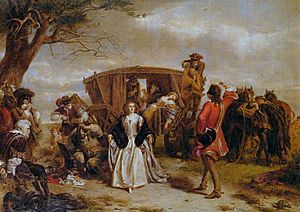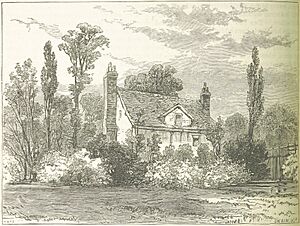Claude Duval facts for kids
Quick facts for kids
Claude Deval (The Marquis)
|
|
|---|---|

William Powell Frith's 1860 painting, Claude Duvall
|
|
| Born | 1643 |
| Died | 21 January 1670 (aged 26–27) |
| Resting place | St Paul's, Covent Garden, London, England |
| Nationality | French |
| Other names | Claude Duvall |
| Occupation | servant, highwayman |
| Known for | French-born highwayman in post-Restoration Britain |
Claude Du Vall (or Duval) (1643 – 21 January 1670) was a French highwayman in Restoration England. He came from a family of decayed nobility, and worked in the service of exiled royalists who returned to England under King Charles II. Little else is known of his history. According to popular legend, he abhorred violence, showing courtesy to his victims and chivalry to their womenfolk, thus spawning the myth of the romantic highwayman, as taken up by many novelists and playwrights.
Early life
Claude Duval was born in Domfront, Orne, Normandy in 1643 to a noble family stripped of title and land. His origin and parentage are in dispute. He did, however, have a brother, Daniel Duval. At the age of 14 he was sent to Paris where he worked as a domestic servant. He later became a stable boy for a group of English royalists and moved to England in the time of the English Restoration as a footman of the Duke of Richmond (possibly a relation) and rented a house in Wokingham.
Highwayman
The legend goes that before long, Duval became a successful highwayman who robbed the passing stagecoaches on the roads to London, especially Holloway between Highgate and Islington and, that unlike most other highwaymen, he distinguished himself with rather gentlemanly behaviour and fashionable clothes.
He reputedly never used violence. One of his victims was Squire Roper, Master of the Royal Buckhounds, whom he relieved of 50 guineas and tied to a tree.
There are many tales about Duval. A particularly famous one – placed in more than one location and later published by William Pope – claims that he took only a part of his potential loot from a gentleman, when the man's wife agreed to dance the "courante" with him in the wayside, a scene immortalised by William Powell Frith in his 1860 painting Claude Duval.
If his intention was to deter pursuit by his non-threatening behaviour, he did not totally succeed. After the authorities promised a large reward, he fled to France for some time but returned a few months later. Shortly afterwards, he is said to have been arrested in the Hole-in-the-Wall tavern in London's Chandos Street, Covent Garden.
Execution
On 17 January 1670, judge Sir William Morton found him guilty of six robberies (others remained unproven) and sentenced him to death. Despite many attempts to intercede, the King did not pardon him and he was executed on 21 January at Tyburn. When his body was cut down and exhibited in Tangier Tavern, it drew a large crowd. It is traditionally thought Duval was buried under the centre aisle of the church of St Paul's, Covent Garden; the parish register notes the burial of a "Peter Duval" in January 1670.
A memorial at the church reads:
- Here lies DuVall: Reder, if male thou art,
- Look to thy purse; if female, to thy heart.
- Much havoc has he made of both; for all
- Men he made to stand, and women he made to fall
- The second Conqueror of the Norman race,
- Knights to his arm did yield, and ladies to his face.
- Old Tyburn’s glory; England’s illustrious Thief,
- Du Vall, the ladies' joy; Du Vall, the ladies' grief.[1]
The apparently gallant highwayman inspired a number of biographers and playwrights to add to his legend, including claims of alchemy, gambling, and much womanising.
He is reported to haunt the Holt Hotel along the A4260 (Oxford Road) in Oxfordshire, a hotel where he spent many nights when it was a small coaching inn.


